Drinking Water Protection
- Drinking Water Protection Home
- About Us
- A-Z Index of Contaminants in Water
- Community Public Water Supply
- Drinking Water Grants and Loans
- Drinking Water Institute
- Drinking Water in Schools and Child Cares
- Drinking Water Revolving Fund
- Laws and Rules
- Noncommunity Public Water Supply
- Source Water Protection
- Water Operator and Certification Training
- Drinking Water Protection Contacts
Related Topics
- Annual Reports
- Drinking Water Risk Communication Toolkit
- Drinking Water Protection External Resources
- Fact Sheets
- Forms
- Invisible Heroes Videos: Minnesota's Drinking Water Providers
- Noncom Notes Newsletter
- Sample Collection Procedures (videos, pictures, written instructions)
- Waterline Newsletter
Related Sites
- 10 States Standards
- Clean Water Fund
- Health Risk Assessment – Guidance Values and Standards for Water
- Minnesota Well Index
- Water and Health
- Wells and Borings
Environmental Health Division
Waterline: Spring 2024

Editor:
Stew Thornley
Editor:
Noel Hansen, Erin Culver, Bob Smude
Subscribe to The Waterline newsletter. An e-mail notice is sent out each quarter when a new edition is posted to the web site.
On this page:
- Drinking Water Institute teachers return for follow-up in Eden Prairie
- Former Vikings star Chad Greenway to be keynote speaker at Metro School
- Water Bar a Hit at Sauna Village
- Upping our game on cybersecurity
- Artist-in-residence promotes source water protection
- Corn cob crowned
- Comings and goings and shiftings
- Minnesota communities receive Fluoridation Quality Awards
- WIIN program offers help for schools and child cares in reducing lead in water
- Links for proposed Lead and Copper Rule improvements
- Win-Win-Win for Eden Prairie and its customers
- We Are Water Minnesota sites named for 2024
- Drinking Water Action Plan to help identify inequities
- Quote of the quarter
- Reminder to all water operators
- Calendar
Drinking Water Institute teachers return for follow-up in Eden Prairie
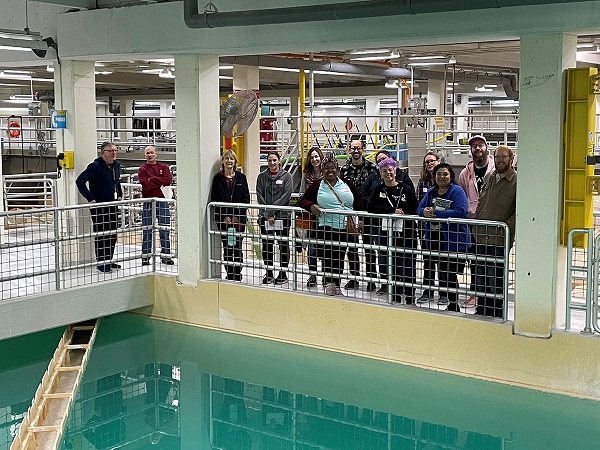
Science teachers from the 2023 Drinking Water Institute gathered in December for a follow-up session in Eden Prairie and got a tour of the city’s water facility.
The 2023 Institute had been held August 7-9 in Minneapolis. Sponsored by the Minnesota Department of Health and the Minnesota Section of American Water Works Association, the Institute has been held since 2001. Science teachers from around the state come together and develop action plans to create inquiry-based activities they can integrate into their existing science curriculum. In addition to the tour, teachers presented their action plans for incorporating what they’ve learned into their existing science curriculum.
The 2024 Institute will be July 29-31 at St. Paul Regional Water Services.
Water Works! A Drinking Water Institute for Educators
Go to top
Former Vikings star Chad Greenway to be keynote speaker at Metro School
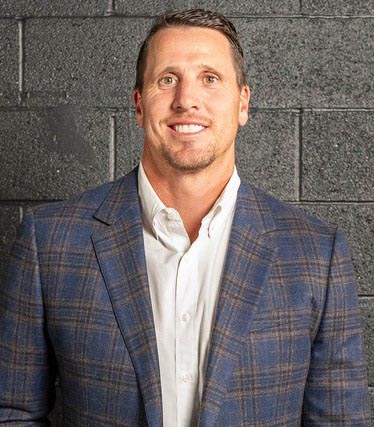
Former Minnesota Vikings linebacker will be the keynote speaker at the Metro District Water Operators School at the Eagan Community Center May 7-9. Greenway was raised on a cattle farm in South Dakota and attended the University of Iowa on a football scholarship. A first-round draft pick of the Vikings in 2006, he played 10 years for the team and was an All-Pro in 2012. In 2015 he received the Whizzer White Award from the National Football League Players Association for community service. Since his retirement, he is still active in coaching and speaking on leadership.
Go to top
Water Bar a Hit at Sauna Village
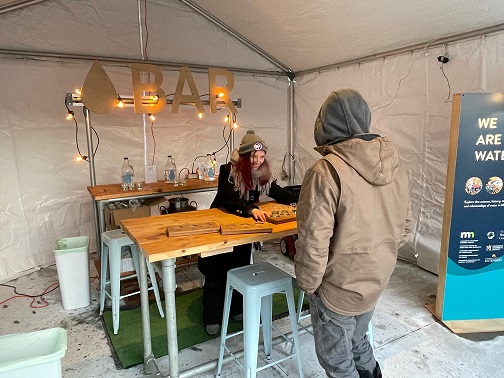
Water Bar, a popular institution at the State Fair and other venues, is back and was at The Great Northern Sauna Village at The Market at Malcolm Yards in Minneapolis. Water Bar has been a combination of water and art with watertenders serving water from a variety of cities in Minnesota. The Great Northern is an organization that celebrates our “cold, creative winters” through diverse programing. Its mission statement includes, “Minnesota does cold better than anywhere else.”
Go to top
Upping our game on cybersecurity

A foreign group known as Cyber Av3ngers reportedly took control of a booster station that manages water pressure at a Pennsylvania utility in 2023. An alarm alerted employees, who disabled the control system and manually maintained water pressure. A couple of years ago, the Federal Bureau of Investigation, National Security Agency, and Cybersecurity and Infrastructure Security Agency (CISA) issued on advisory about Russian state-sponsored cyberoperations against critical infrastructure, including U. S. water and wastewater facilities and operations.
Such threats emphasize the need for vigilance, and cybersecurity is a key part of the 2018 America’s Water Infrastructure Act, which requires community water systems serving a population of 3,300 or more to assess cybersecurity threats as part of a risk and resilience assessment and incorporate strategies that address cybersecurity in emergency response plans.
All community water systems in Minnesota that use operational technology such as SCADA must perform a cybersecurity assessment every year. As part of a sanitary survey, Minnesota Department of Health district engineers will ask about the assessment and if any issues were discovered. In 2024 community systems with operational technology will have to certify to MDH that an assessment was performed, either by the utility or a third party.
Resources for self-assessments:
U. S. Environmental Protection Agency (EPA) Cybersecurity for the Water Sector
EPA Water Section Cybersecurity Evaluation Program
CISA Cyber Resilience Review
National Institute of Standards and Technology Cybersecurity Framework
American Water Works Association Cybersecurity & Guidance
A few more tips (from the Spring 2022 Waterline)
- Use long passwords (at least 18 characters), and do not reuse passwords nor variations of them. Andrew Hildick-Smith of the Water Information Sharing and Analysis Center says, “Winter2021!” may meet minimum standards but “it is a dud.” He recomments passphrases, such as “astrid#lunar68spitBALL,” which are long and complicated but that can be remembered.
- Back up data. Isolate backups from the network and rotate physical backup media offsite. Test the restoration process if the backups are needed.
- Minimize gaps in staff coverage, especially during holiday seasons. Have a responder on retainer. Partner with neighboring utilities.
- Have contact information for staff and responders updated and readily available.
- In case of an attack, respond by isolating affected systems.

- Maintain paper copies of information. Recovery, if there is an attack, involves eradication and restoration.
- Avoid pop-ups and emails from suspicious or unknown people.
- Check the URL of sites. Type in a URL rather than clicking on the first link found in a search engine.
- Keep your software updated.
- Be aware of the latest cybersecurity trends and new malware.
Questions about cybersecurity may be directed to MDH engineers Kim Larsen and Lucas Hoffman.
Go to top
Artist-in-residence promotes source water protection
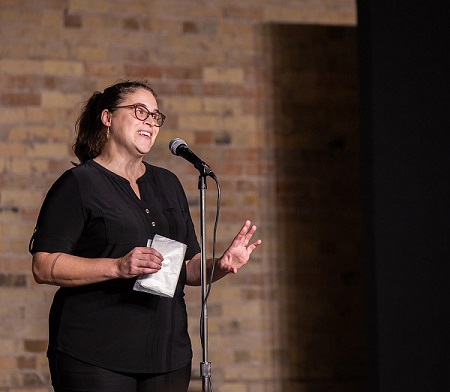
The Source Water Protection Collaborative recently wrapped up a project that commissioned artist Su Legatt to engage the residents of Little Falls on source water protection through art-making and community events. Legatt is a Minnesota-based artist, educator, and community organizer. Through an artist-in-residence period from June to December 2023, Su held events and conversations with community leaders, educators, artists, and other residents to develop artwork that explored the community’s relationship to and understanding of its source water, and how important groundwater is to the community at large. Little Falls residents engaged in paper-making activities and produced paintings and poetry that were married to develop a series of broadsides reflecting community values, perspectives, and experiences around water. The broadsides are on display at Little Falls City Hall and are being reproduced as window clings and vinyl wraps around the community. Prints are available for purchase at Great River Arts and on Su’s website; all proceeds will go to Friends of Crane Meadows to expand their water protection efforts.
The Source Water Protection Collaborative is Minnesota-based statewide partnership dedicated to promoting land use that safeguards drinking water sources, convened by Environmental Initiative, supported by the Minnesota Department of Health, and made possible by Clean Water Fund.
Go to top
Corn cob crowned
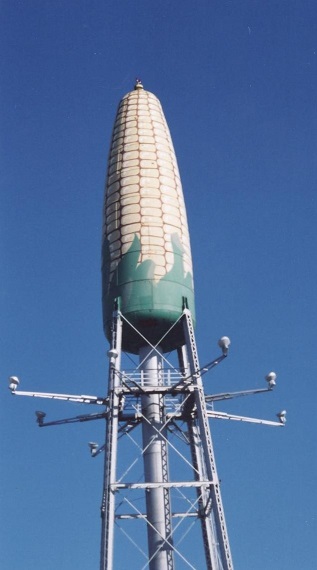
A familiar water tower in Rochester received special status as the city’s Historic Preservation Commission voted unanimously in December 2023 to designate the tower as an historic structure. The Rochester city council approved the designation the following month.
The tower is 151 feet high and was built in 1931 by Reid, Murdoch and Company to supply its canning plant. The plant, last operated by Seneca Foods, has been demolished, but the tower lives on and is now owned by Olmsted County. A member of the preservation commission called it, “Rochester’s Eiffel Tower of Corn.”
Go to top
Comings and goings and shifting
Pat Shea, the general manager at St. Paul Regional Water Services, has flown south to work for Manatee County in Florida. Shea is the Minnesota Section’s director on the American Water Works Association board of directors and will continue to be active in and attend the Minnesota Section annual conference.
At the Minnesota Department of Health (MDH), Kim Larsen is the new supervisor of the Community Public Water Supply Unit. Larsen joined MDH as a district engineer in St. Cloud in 2005 and became the operations supervisor for the central and southern part of the state in 2018. She has also been the program lead in emergency response, cybersecurity, risk and resiliency management, sanitary surveys, and infectious waterborne diseases.
Amy Lynch and Lucas Hoffman are the new operations supervisors, succeeding Larsen and Todd Johnson, who is now the Drinking Water Revolving Fund program coordinator in the MDH Infrastructure Unit.
Go to top
Minnesota communities receive Fluoridation Quality Awards

The Centers for Disease Control and Prevention (CDC) announced recipients of the Water Fluoridation Quality Award for water systems that achieved excellence in community water fluoridation by maintaining a consistent level of fluoride in drinking water. Minnesota was among the 27 states that had systems honored. In Minnesota, 63 fluoridating community water systems received the award.
“Water fluoridation is one of the best investments that a community can make in maintaining the oral health of its citizens. It is equally as effective in preventing cavities in children and adults,” said Casey Hannan of the CDC. “Studies continue to show that for every $1 a community invests in water fluoridation, $20 is saved in dental treatment costs.”
Prasida Khanal, the state oral health director at the Minnesota Department of Health, urged recipients to use their award in promoting health through community water fluoridation and added, “It provides you with an opportunity to highlight the excellent work being done by your water system.”
Khanal also noted that the Health Department provides grants for hydration stations to promote the drinking of fluoridated tap water over sugary beverages. The hydration stations also help mitigate lead in the water (see story below).
To learn more about the grants, educational materials, and other resources, contact health.oral@state.mn.us.
More information:
Oral Health Resources for Families
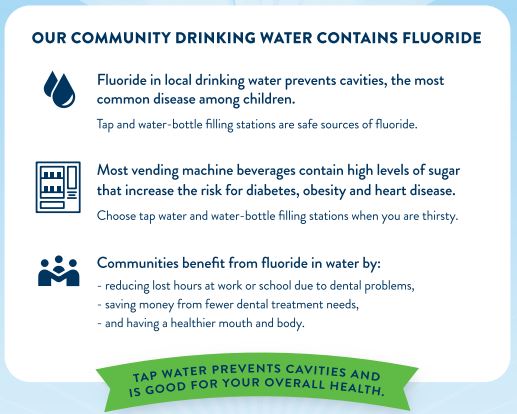
Go to top
WIIN program offers help for schools and child cares in reducing lead in water
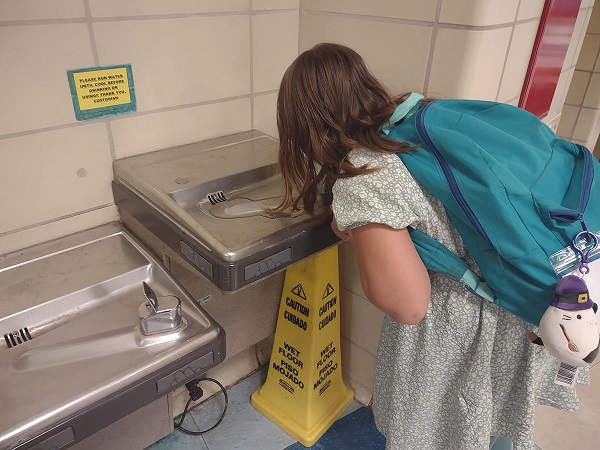
Lead is a toxic metal commonly found in air, soil, dust, food, paint, and drinking water. Lead can cause adverse health effects related to memory, I.Q., kidney function, blood pressure, and fertility and miscarriages There is no safe level for lead in the body. Reducing levels of lead in drinking water is an important part of reducing the overall exposure to lead.
Young children are one of the highest risk groups for lead exposure because they’re still growing, and their brains are still developing, the Minnesota Department of Health (MDH) has a special focus on schools and child-care facilities. Water-use patterns in these places may cause greater challenges. Often, water in the pipes may be stagnant—over vacations, holidays, and long weekends—causing more opportunities for lead to get into the water.
To help with the costs of testing in these facilities, MDH received a federal Water Infrastructure Improvements for the Nation (WIIN) grant from the U. S. Environmental Protection Agency to develop a voluntary lead in drinking water testing program for eligible schools, child care, and Head Start programs.
WIIN grants provide free test kits and laboratory analysis for lead in drinking water. MDH also provides technical assistance to interpret results and training on best water management practices in buildings.
The WIIN program begins with an orientation and help in developing a sample plan. Upon being provided with test kits, a facility will collect water samples after an 8-to-18-hour stagnation period when the water isn’t being used in the building. The samples will be sent, with pre-paid shipping labels, to the MDH Public Health Laboratory in St. Paul, and the results provided within a few weeks to the facility.
From there, MDH will work with the facility whether or not remediation is necessary and and provide a toolkit with templates and communication materials.
MDH has provided other funding, including the purchase of six hydration stations in 2023.
A Lead in Drinking Water Remediation grant will be available in the future to assist schools and child cares.
Questions? Contact HEALTH.WIIN_Grant@state.mn.us.
More Information:
Minnesota Lead Testing in Schools and Child Care in Drinking Water
Minnesota Lead in Schools and Child Cares Testing Program
Go to top
Links for proposed Lead and Copper Rule improvements
The U. S. Environmental Protection Agency has announced proposed improvements to the Lead and Copper Rule.
Proposed Lead and Copper Rule Improvements - Summary
Proposed Lead and Copper Rule Improvements - Fact Sheet (PDF)
Go to top
Win-Win-Win for Eden Prairie and its customers
The city of Eden Prairie wanted to spread the word to help its customers avoid a costly mistake encountered by a family in late 2023. Upon receiving a higher-than-usual water bill, the woman called the utility and was told that water was constantly running in her house, probably from a toilet. The woman checked a bathroom, one rarely used on a lower level, and found it to be the case. The city’s water metering customer portal app, “Eye on Water,” connects to smart phones, and, after being directed on how to download the app, she clearly saw on her phone the continuous low flow through her meter. The leak went back more than four months and resulted in 10 times the usage that she and her husband and daughters normally experienced. An inexpensive remedy fixed the problem and got the family’s usage—and water bill—back to normal.
Rick Wahlen, the operations manager for Eden Prairie utilities, worked with a local reporter to publicize the water app so others could avoid similar problems. “The newspaper got a fascinating and relatable front-page story to make their publication relevant, the journalist got a good story to add to his portfolio, and the city got a perspective from a local resident from her real-world experience that should be much more effective at encouraging the public to take advantage of this program than the typical top-down information campaigns used by local government,” said Wahlen. “Within 24 hours of the story’s publication, 134 water customers connected on-line to monitor water use.
“It’s a good water conservation example, but maybe the public relations example is just as useful.”
News story: Eden Prairie residents urged to keep an eye on their water usage
Go to top
We Are Water Minnesota sites named for 2024
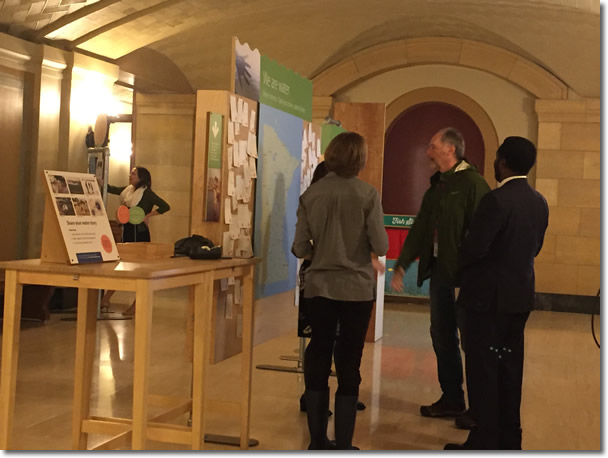
The We Are Water Minnesota exhibit at Prairie Woods Environmental Learning Center outside Spicer in 2016.
The We Are Water Minnesota will be in five locations across the state in 2024. The traveling display explores the connections between the humanities and water through an exhibit, public events, and educator resources. It also examines three ways of knowing water: personal stories, historical content, and scientific information. Visitors can explore stories both local and statewide and share their own stories of water’s importance in their life.
We Are Water MN is a partnership involving a number of state agencies, including the Minnesota Department of Health, to bring together personal stories, historical materials, and scientific information
The schedule for 2024: Duluth February 29-April 22;Sartell April 25-June 17; Chisago County June 20 to August 12; Leech Lake Tribal Council August 15 to October 7; and Shakopee Mdewakanton Sioux Community October 10 to December 5.
More information:
Go to top
Drinking Water Action Plan to help identify inequities
The Minnesota Drinking Water Action Plan is a 10-year plan to ensure that all Minnesotans have equitable access to safe and sufficient drinking water. It is in response to the Minnesota Legislature and Clean Water Council’s charge to Minnesota Department of Health to “ . . . develop public health policies and an action plan to address threats to safe drinking water, including development of a statewide plan for protecting drinking water based on recommendations from the [University of Minnesota] Future of Drinking Water report.”
The plan highlights the state’s commitment to protect against existing and emerging threats that endanger safe drinking water and helps identify health inequities, along with how to address them, in our current management system. It aims to allow Minnesotans to be confident in the safety of their water whether if is from a public water system or private well, groundwater or surface source, and regardless of their zip code, race, ethnicity, dominant language, sexual orientation, age, or socio-economic status.
By the end of 2024, the plan will define actionable strategies and polices to ensure safe drinking water and will run through 2034.
Go to top
Quote of the quarter
I don't mind going nowhere as long as it's an interesting path.
Go to top
Reminder to all water operators
When submitting water samples for analyses, remember to do the following:
- Take coliform samples on the distribution system, not at the wells or entry points.
- Write the Date Collected, Time Collected, and Collector’s Name on the lab form.
- Attach the label to each bottle (do not attach labels to the lab form).
- Include laboratory request forms with submitted samples.
- Do not use a rollerball or gel pen (the ink may run).
- Consult your monitoring plan(s) prior to collecting required compliance samples.
Notify your Minnesota Department of Health district engineer of any changes to your systems.
Go to top
Calendar
Operator training sponsored by the Minnesota Department of Health and Minnesota AWWA will be held in the coming months.
Register for schools and pay on-line:
Go to top